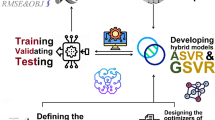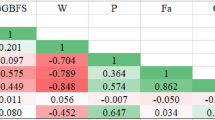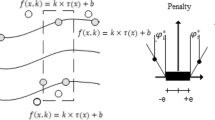Abstract
In recent years, many experimental articles have been conducted to study ultra-high-performance concrete (UHPC). Thus, the relationship between its blend composition and the mechanical properties of UHPC is highly non-linear and challenging to utilize conventional statistical approaches. A robust and sophisticated method is needed to rationalize the variety of relevant experimental datasets, provide insight into aspects of non-linear materials science, and make estimative tools of desirable accuracy. Machine learning (ML) is a potent strategy that can reveal underlying patterns in complex datasets. This study aims to employ state-of-the-art ML methods for predicting the UHPC compressive strength (CS) by operating 165 previously published samples with 8 input characteristics via support vector regression (SVR). In addition, a novel approach has been used based on meta-heuristic algorithms to enhance accuracy, including Dynamic Arithmetic Optimization Algorithm (DAOA), Arithmetic Optimization Algorithm (AOA), and Black Widow Optimization (BWO). Furthermore, the models evaluated the prediction input dataset by some criteria indicators. The results indicated that the represented models obtained suitable estimative efficiency and can be reliable on ML methods in saving time and energy. In general, in comparing hybrid models, SVDA has a more acceptable performance than other hybrid models.









Similar content being viewed by others
Data availability
The authors do not have permissions to share data.
References
Abellán García J, Fernández Gómez J, Torres Castellanos N (2020) Properties prediction of environmentally friendly ultra-high-performance concrete using artificial neural networks. Eur J Environ Civ Eng 1–25
Abuodeh OR, Abdalla JA, Hawileh RA (2020) Assessment of compressive strength of Ultra-high Performance Concrete using deep machine learning techniques. Appl Soft Comput 95:106552
Akbarzadeh MR, Ghafourian H, Anvari A, Pourhanasa R, Nehdi ML (2023) Estimating compressive strength of concrete using neural electromagnetic field optimization. Materials (basel) 16:4200
Alabduljabbar H, Khan M, Awan HH, Eldin SM, Alyousef R, Mohamed AM (2023) Predicting ultra-high-performance concrete compressive strength using gene expression programming method. Case Stud Constr Mater 18:e02074
An S-H, Park U-Y, Kang K-I, Cho M-Y, Cho H-H (2007) Application of support vector machines in assessing conceptual cost estimates. J Comput Civ Eng 21:259–264
Awodiji CTG, Onwuka DO, Okere C, Ibearugbulem O (2018) Anticipating the compressive strength of hydrated lime cement concrete using artificial neural network model. Civ Eng J 4:3005–3018
Behnam S, Tejani GG, Kumar S (2023) Predict the maximum dry density of soil based on individual and hybrid methods of machine learning. Adv Eng Intell Syst. https://doi.org/10.2203/aeis.2023.414188.1129
Castelli M, Vanneschi L, Silva S (2013) Prediction of high performance concrete strength using genetic programming with geometric semantic genetic operators. Expert Syst Appl 40:6856–6862
Çevik A, Kurtoğlu AE, Bilgehan M, Gülşan ME, Albegmprli HM (2015) Support vector machines in structural engineering: a review. J Civ Eng Manag 21:261–281
Chang W, Zheng W (2020) Effects of key parameters on fluidity and compressive strength of ultra-high performance concrete. Struct Concr 21:747–760
Chen B-T, Chang T-P, Shih J-Y, Wang J-J (2009) Estimation of exposed temperature for fire-damaged concrete using support vector machine. Comput Mater Sci 44:913–920
Cheng H, Kitchen S, Daniels G (2022) Novel hybrid radial based neural network model on predicting the compressive strength of long-term HPC concrete. Adv Eng Intell Syst 1(02):1–11
Chou JS, Tsai CF, Pham AD, Lu YH (2014) Machine learning in concrete strength simulations: multi-nation data analytics. Constr Build Mater 73:771–780. https://doi.org/10.1016/j.conbuildmat.2014.09.054
Ghafari E, Bandarabadi M, Costa H, Júlio E (2012) Design of UHPC using artificial neural networks. Brittle Matrix Compos, vol 10. Elsevier, pp 61–69
Graybeal BA (2007) Compressive behavior of ultra-high-performance fiber-reinforced concrete. ACI Mater J 104:146
Huang L, Jiang W, Wang Y, Zhu Y, Afzal M (2022) Prediction of long-term compressive strength of concrete with admixtures using hybrid swarm-based algorithms. Smart Struct Syst 29:433–444
Kasperkiewicz J, Racz J, Dubrawski A (1995) HPC strength prediction using artificial neural network. J Comput Civ Eng 9:279–284
Khodadadi N, Snasel V, Mirjalili S (2022) Dynamic arithmetic optimization algorithm for truss optimization under natural frequency constraints. IEEE Access 10:16188–16208
Liang H, Song W (2009) Improved estimation in multiple linear regression models with measurement error and general constraint. J Multivar Anal 100:726–741
Maity R, Bhagwat PP, Bhatnagar A (2010) Potential of support vector regression for prediction of monthly streamflow using endogenous property. Hydrol Process an Int J 24:917–923
Masoumi F, Najjar-Ghabel S, Safarzadeh A, Sadaghat B (2020) Automatic calibration of the groundwater simulation model with high parameter dimensionality using sequential uncertainty fitting approach. Water Supply 20:3487–3501. https://doi.org/10.2166/ws.2020.241
Mattei NJ, Mehrabadi MM, Zhu H (2007) A micromechanical constitutive model for the behavior of concrete. Mech Mater 39:357–379
Mukherjee S, Osuna E, Girosi F (1997) Nonlinear prediction of chaotic time series using support vector machines. Neural Networks Signal Process. VII. Proc. 1997 IEEE Signal Process. Soc. Work., IEEE; pp 511–520
Samui P (2008) Support vector machine applied to settlement of shallow foundations on cohesionless soils. Comput Geotech 35:419–427
Shafieifar M, Farzad M, Azizinamini A (2018) A comparison of existing analytical methods to predict the flexural capacity of Ultra High Performance Concrete (UHPC) beams. Constr Build Mater 172:10–18
Shi X, Dong Y (2011) Support vector machine applied to prediction strength of cement. 2011 2nd Int. Conf. Artif. Intell. Manag. Sci. Electron. Commer., IEEE; 2011, pp 1585–1588
Vapnik V (1999) The nature of statistical learning theory. Springer science & business media
Vapnik V (2013) The nature of statistical learning theory. Springer science & business media
Vapnik V, Golowich S, Smola A (1996) Support vector method for function approximation, regression estimation and signal processing. Adv Neural Inf Proc Syst 9:1–7
Wille K, Naaman AE, El-Tawil S, Parra-Montesinos GJ (2012) Ultra-high performance concrete and fiber reinforced concrete: achieving strength and ductility without heat curing. Mater Struct 45:309–324
Wu M (2023) Using the two optimization algorithms (BBO and FDA) coupling with radial basis neural network to estimate the compressive strength of high-ultra-performance concrete. J Intell Fuzzy Syst 44(1):827–837
Ye Q, Huang Q, Gao W, Zhao D (2005) Fast and robust text detection in images and video frames. Image vis Comput 23:565–576
Yin H, Liu S, Lu S, Nie W, Jia B (2021) Prediction of the compressive and tensile strength of HPC concrete with fly ash and micro-silica using hybrid algorithms. Adv Concr Constr 12:339–354
이종재, 김두기, 장성규, 이장호 (2007) Application of support vector regression for the prediction of concrete strength. Comput Concr An Int J 4:299–316
Author information
Authors and Affiliations
Contributions
BL: writing—original draft preparation, conceptualization, supervision, project administration.
Corresponding author
Ethics declarations
Conflict of interest
The authors declare no competing of interests.
Additional information
Publisher's Note
Springer Nature remains neutral with regard to jurisdictional claims in published maps and institutional affiliations.
Rights and permissions
Springer Nature or its licensor (e.g. a society or other partner) holds exclusive rights to this article under a publishing agreement with the author(s) or other rightsholder(s); author self-archiving of the accepted manuscript version of this article is solely governed by the terms of such publishing agreement and applicable law.
About this article
Cite this article
Liu, B. Estimating the ultra-high-performance concrete compressive strength with a machine learning model via meta-heuristic algorithms. Multiscale and Multidiscip. Model. Exp. and Des. (2023). https://doi.org/10.1007/s41939-023-00302-5
Received:
Accepted:
Published:
DOI: https://doi.org/10.1007/s41939-023-00302-5




